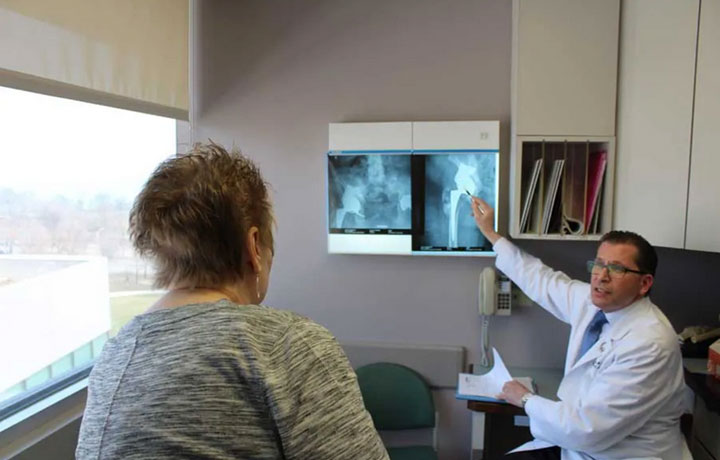Recently released research from the American Academy of Orthopaedic Surgeons (AAOS) reflects current trends in knee and hip replacements being seen at Weiss Memorial Hospital.
“One area the study confirms is the rapid growth of hip and knee revisions,” says Henry Finn, MD, medical director of the Chicago Center for Orthopedics (CCO) at Weiss Memorial Hospital, and professor of orthopedic surgery at the University of Chicago. “An uptick in first-time total knee and hip replacements started in the mid-1990s, and its growth has stayed consistent over the past two decades. Now, those individuals need a new implant.” Knee and hip implants typically last 20 to 25 years.
As a hip and knee revisionist, Dr. Finn sees his share of patients needing hip and knee “re-dos.” He anticipates the exponential growth of hip revisions in the decades to come as he sees younger patients in need of knee and hip replacement – primarily due to active and athletic adults wanting to keep up with their quality life as they age and the obesity epidemic. Both lifestyles add stress to the joints, which accelerates joints wearing down and the onset of arthritis – the leading reasons people get joint replacement surgery.
The latest numbers show 370,770 total hip replacements and 680,150 total knee replacements in 2014. Revisions make up about 10 percent of these surgical procedures, so 37,000 and 68,000 respectively.
The latest research predicts a more than 170 percent jump in primary joint replacements – an estimated 635,000 hip and 1.28 million knee procedures, respectively, by 2030. For revision surgery, the statistics are expected to increase by more than 140 percent: 72,000 procedures for hip revisions and 120,000 procedures for knee revisions.
“Despite the complexity of these revision surgeries and high risk of complications, the increased need for them is driving the development of better implants and techniques, which only benefits patients,” Finn notes.
Julie Tamason of suburban Chicago is among the patients leading the way of this trajectory of hip revisions. She was 42 when she first got her hip replaced, the result of a congenital condition and early onset arthritis. All went well until age 59.

“Chronic pain set in, much of the pain felt like it was in my lower back”
Tamason said. “I thought I injured my spine and needed back surgery. I walked crooked, and it got to a point where I could hardly move.” She had trouble sleeping because of the pain. She stopped driving because she couldn’t put weight on her one leg.
Tamason became depressed due to losing her independence. “I was actually crying from the pain.” Her 35-year-old daughter took on a caregiver role. The stress of the situation became so great for her, she encouraged her mother to seek treatment. Tamason did, and after her 9-month run with severe pain, her doctor told her she needed a hip revision.
“The ball implanted at the top of Ms. Tamason’s femur bone came out of the socket, making her one leg a few inches shorter than the other,” Dr. Finn explained. “We reconstructed her pelvis using a cup cage, pins, a new ball and socket implant and bone grafting. It’s a highly complex surgery.”
“What a turnaround!” Tamason explains. Two months post-surgery she says, “The pain has subsided. I walk differently. I’m doing things for myself again. I have a new lease on life, a second chance. And I’m so thankful to Dr. Finn. He’s a healer.” The implants are expected to last more than 20 years.
The revision total hip acetabulum utilized cup cage construct and bone grafting procedure is becoming more commonplace in Dr. Finn’s practice. He also sees his share of knee revisions too. Read more about the impact a condition known as arthrofibrosis – the aggressive build-up of scare tissue following a knee replacement – is having on knee revisions.
Patients are advised to choose their revision surgeon wisely to avoid complications and make implants last as long as possible, reducing surgeries in their lifetime. One of the best indicator of a successful surgeon is volume. Studies show the more surgeries a doctor does, the more skilled he/she will be.
“Ten years from now, it might be common for surgeons to see patients who are undergoing their second or third joint revision surgery, as more people get their first knee or hip replaced before age 45,” Finn predicts.
Study: Projected Volume of Primary and Revision Total Joint Arthroplasty in the United States, 2030-2060, Matthew Sloan, Neil P Sheth, 2018 Annual Meeting of the American Academy of Orthopaedic Surgeons (AAOS), link.
